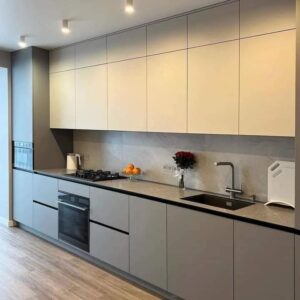Steel Kitchen Design By Karvi Interio 2024

In the realm of contemporary kitchen design, steel has emerged as a leading material, offering both elegance and functionality. Known for its durability, sleek appearance, and ease of maintenance, steel kitchens are becoming increasingly popular among homeowners looking to enhance their cooking spaces. This comprehensive guide delves into the world of steel kitchen design, exploring its benefits, key features, design ideas, and tips for creating a stunning and efficient kitchen with steel elements.
Steel Kitchen Design
1. Introduction to Steel Kitchen Design
Steel kitchen design refers to the incorporation of steel as a primary material in kitchen cabinetry, countertops, appliances, and fixtures. Steel is prized for its strength, resistance to corrosion, and modern aesthetic. It can be used in various ways to create a kitchen that is both stylish and practical.
Why Choose Steel for Your Kitchen?
Steel offers several advantages that make it an attractive choice for modern kitchens:
- Durability: Steel is highly durable and resistant to scratches, dents, and stains, ensuring that your kitchen maintains its appearance over time.
- Modern Aesthetic: Steel provides a sleek, contemporary look that complements various design styles, from industrial to minimalist.
- Ease of Maintenance: Steel surfaces are easy to clean and maintain, requiring minimal effort to keep them looking pristine.
- Heat Resistance: Steel can withstand high temperatures, making it ideal for use around stoves and ovens.
2. Benefits of Steel Kitchen Design
Steel kitchens offer a range of benefits that contribute to their growing popularity. Here’s a closer look at some of the key advantages:
a) Durability and Longevity
Steel is renowned for its strength and durability. Unlike wood or laminate, steel is resistant to physical damage, such as scratches and dents. This makes it an ideal choice for high-traffic areas like the kitchen.
- Scratch and Dent Resistance: Steel surfaces are less likely to show signs of wear and tear.
- Long-Term Investment: A steel kitchen can last for decades with proper care, making it a cost-effective investment.
b) Sleek and Modern Look
The polished and shiny surface of steel adds a touch of sophistication to any kitchen. Steel can be used to achieve a variety of looks, from sleek and modern to industrial chic.
- Reflective Finish: Steel’s reflective quality enhances light in the kitchen, making the space feel brighter and more open.
- Versatile Design: Steel complements a range of design styles, including contemporary, industrial, and even traditional.
c) Low Maintenance Requirements
One of the major benefits of steel is its low maintenance requirements. Steel surfaces are easy to clean and resistant to stains and spills.
- Easy Cleaning: Wipe down steel surfaces with a damp cloth and mild detergent to keep them clean.
- Stain Resistance: Steel is less likely to absorb stains, making it easier to maintain a clean appearance.
d) Heat and Water Resistance
Steel’s ability to withstand high temperatures and moisture makes it an ideal material for kitchen environments.
- Heat Resistance: Steel does not warp or discolor under high heat, making it suitable for use around stoves and ovens.
- Water Resistance: Steel’s non-porous surface prevents water from seeping in and causing damage.
3. Key Features of Steel Kitchen Design
When designing a steel kitchen, there are several key features to consider to ensure a functional and aesthetically pleasing space:
a) Steel Cabinetry
Steel cabinetry offers a modern and durable solution for kitchen storage. Here’s what to look for:
- Finish Options: Steel cabinets come in various finishes, including brushed, polished, and matte. Each finish offers a different look and level of reflection.
- Customization: Choose from pre-fabricated or custom-designed cabinets to fit your kitchen’s layout and style.
- Integrated Handles: Consider handles that are integrated into the cabinet design for a sleek, minimalist look.
b) Steel Countertops
Steel countertops provide a durable and stylish surface for food preparation and cooking.
- Seamless Design: Steel countertops can be designed with seamless joints, providing a sleek and modern appearance.
- Integrated Sink: An integrated steel sink offers a continuous surface that is both practical and visually appealing.
- Backsplashes: Pair steel countertops with matching backsplashes to create a cohesive look.
c) Steel Appliances
Incorporating steel appliances into your kitchen design enhances both functionality and style.
- Stainless Steel Finish: Stainless steel appliances are popular for their modern look and resistance to fingerprints and smudges.
- Built-In Options: Consider built-in appliances for a streamlined appearance that integrates seamlessly with your cabinetry.
d) Steel Fixtures and Hardware
Steel fixtures and hardware contribute to the overall design and functionality of the kitchen.
- Faucets and Sinks: Choose steel faucets and sinks that complement your cabinetry and countertops.
- Drawer Handles and Knobs: Opt for steel handles and knobs that match the finish and style of your cabinets.
4. Design Ideas for Steel Kitchens
Steel kitchens offer a range of design possibilities, from industrial to contemporary. Here are some design ideas to inspire your steel kitchen:
a) Industrial Chic
Embrace the industrial style with exposed steel elements and a rugged, urban aesthetic.
- Exposed Steel Beams: Highlight structural steel beams or pipes to create an industrial look.
- Concrete Floors: Pair steel cabinetry with concrete floors for a cohesive industrial design.
- Open Shelving: Use open steel shelving to display kitchenware and add to the industrial vibe.
b) Sleek and Modern
Create a sleek and modern kitchen with clean lines and a minimalist design.
- High-Gloss Finish: Opt for high-gloss steel cabinetry to achieve a polished, modern look.
- Minimalist Hardware: Use integrated handles or minimal hardware for a streamlined appearance.
- Monochromatic Color Scheme: Stick to a monochromatic color scheme with steel as the primary material to enhance the modern aesthetic.
c) Classic Elegance
Combine steel with classic design elements for a timeless and elegant kitchen.
- Traditional Cabinetry: Use steel cabinetry with traditional paneling and molding for a classic look.
- Marble Accents: Incorporate marble countertops or backsplashes to add a touch of luxury and sophistication.
- Warm Lighting: Use warm, ambient lighting to create a cozy and inviting atmosphere.
d) Contemporary Fusion
Blend steel with other materials for a contemporary and eclectic design.
- Wood and Steel: Combine steel cabinetry with wooden accents for a warm and modern contrast.
- Glass Elements: Incorporate glass panels or shelves to add transparency and lightness to the design.
- Bold Colors: Use bold, contrasting colors or patterns to create visual interest and energy.
5. Budget Considerations for Steel Kitchen Design
Steel kitchen designs can vary in cost depending on several factors. Here’s how to manage your budget:
a) Material Costs
The cost of steel varies based on its finish and quality. Higher-quality steel and specialized finishes may increase the overall cost.
- Standard Steel: More affordable and commonly used for cabinetry and fixtures.
- Premium Steel: Higher-cost options include specialized finishes and custom designs.
b) Customization
Custom-designed steel elements can increase the cost of your kitchen project.
- Custom Cabinets: Custom steel cabinets and countertops will typically be more expensive than pre-fabricated options.
- Design Services: Professional design services can add to the overall cost but may provide a more tailored and functional kitchen.
c) Installation Costs
Proper installation is crucial for the performance and appearance of your steel kitchen.
- Professional Installation: Hiring a professional installer ensures accurate measurements and proper fitting of steel elements.
- Additional Services: Consider any additional services needed, such as plumbing or electrical work, which may impact the overall cost.
6. Maintenance Tips for Steel Kitchens
Maintaining your steel kitchen ensures that it continues to look and function at its best. Here are some maintenance tips:
a) Regular Cleaning
Steel surfaces are easy to clean but require regular maintenance to prevent buildup.
- Wipe Down: Use a damp cloth and mild detergent to wipe down steel surfaces.
- Avoid Abrasives: Avoid using abrasive cleaners or scrubbers that can scratch the surface.
b) Prevent Stains
While steel is resistant to stains, it’s important to address spills and stains promptly.
- Immediate Cleanup: Clean up spills immediately to prevent staining.
- Use Coasters: Use coasters or mats under hot pots and pans to prevent potential damage.
c) Check for Corrosion
Steel is resistant to corrosion, but it’s still important to check for any signs of rust or damage.
- Inspect Regularly: Check for any rust spots or discoloration and address them promptly.
- Use Protective Coatings: Consider using protective coatings or sealants to prevent rust and extend the life of your steel surfaces.
7. Choosing the Right Steel for Your Kitchen
Selecting the right type of steel is crucial for achieving the desired look and performance in your kitchen. Here’s a guide to different types of steel:
a) Stainless Steel
Stainless steel is the most common choice for kitchen applications due to its durability and resistance to corrosion.
- Type 304: The most widely used grade, known for its resistance to rust and staining.
- Type 316: Higher resistance to corrosion, ideal for areas exposed to moisture and chemicals.
b) Brushed Steel
Brushed steel features a matte finish that hides fingerprints and smudges while adding a subtle texture.
- Aesthetic Appeal: Provides a sleek and modern look with a non-reflective surface.
- Durability: Maintains its appearance over time with minimal maintenance.
c) Polished Steel
Polished steel has a shiny, reflective surface that adds a touch of elegance to the kitchen.
- High Gloss: Creates a high-gloss finish that enhances light and adds a sophisticated touch.
- Maintenance: Requires regular cleaning to maintain its reflective quality and prevent fingerprints.
8. Conclusion: Designing Your Perfect Steel Kitchen
Steel kitchen design offers a blend of modern aesthetics, durability, and practicality. Whether you’re looking for a sleek, contemporary look or a more classic and elegant design, steel provides versatile options to suit various styles and preferences.
By understanding the benefits, key features, and design ideas associated with steel kitchens, you can create a cooking space that is both functional and visually appealing. Consider your budget, maintenance needs, and design preferences when selecting steel elements for your kitchen.
With careful planning and consideration, a steel kitchen can become a standout feature in your home, combining style and functionality to enhance your culinary experience. Embrace the possibilities of steel kitchen design and create a space that reflects your taste and meets your needs for years to come.

